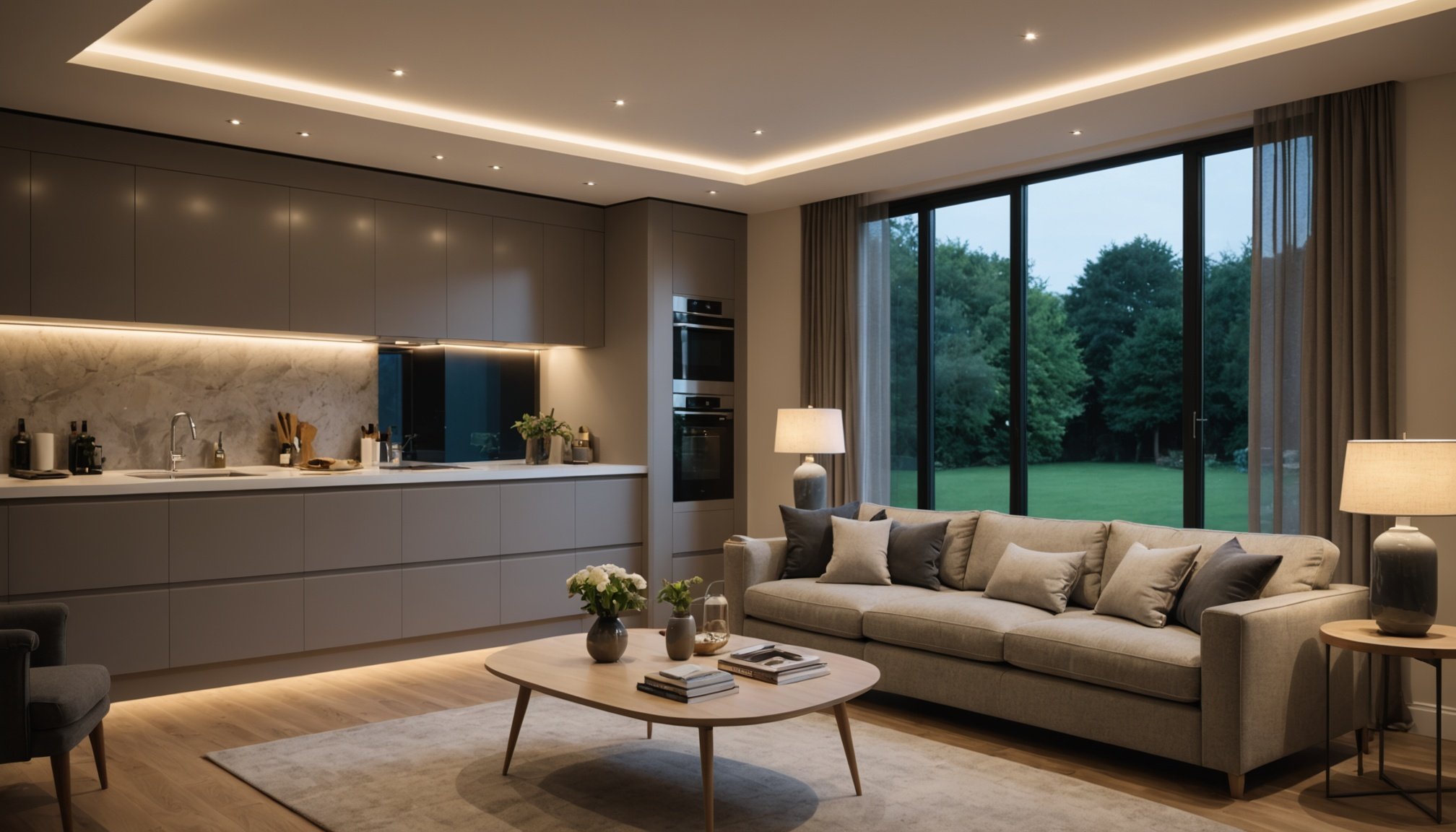Understanding Smart Lighting Solutions
Smart lighting has transformed the way we illuminate our homes, bringing an intelligent twist to traditional lighting. At its core, smart lighting integrates with home automation systems, providing a seamless way to control and manage lights remotely using devices like smartphones or voice-activated assistants.
Incorporating smart lighting into home automation systems not only enhances convenience but also significantly boosts energy efficiency. These systems allow users to schedule lights to turn on or off at specific times, reducing unnecessary usage and lowering energy bills. Many smart lighting solutions also offer sensors that detect motion or ambient light, adjusting the brightness levels automatically for optimal energy-saving benefits.
Avez-vous vu cela : Smart Entryway Solutions: How UK Homeowners Can Effectively Reduce Heat Loss
Popular features of smart lighting systems include the ability to change colours and dim lights according to mood or occasion, creating a personalised ambiance. Some advanced systems even synchronise lighting patterns with entertainment setups, offering an immersive experience.
Beyond convenience and efficiency, smart lighting can enhance security by mimicking occupancy through randomised lighting patterns when the homeowners are away, deterring potential intruders.
Lire également : Effortless Elegance: Designing a Low-Maintenance Front Yard for UK Homeowners
The adoption of smart lighting not only caters to the tech-savvy but also appeals to those seeking an effortless way to maintain a sustainable, efficient, and secure home environment.
Product Recommendations for Smart Lighting
Choosing the right smart lighting products can significantly enhance your home’s ambiance, energy efficiency, and convenience. This section will guide you through the best smart lighting products, highlighting insightful product reviews and comparisons. Below, we break down top picks based on smart bulbs, LED strips, and integrated systems.
Top Smart Bulbs for Home Use
Smart bulbs are the simplest way to introduce intelligent lighting to your home. The best smart lighting products in this category offer easy installation and compatibility with popular virtual assistants like Alexa and Google Assistant. User reviews suggest the Philips Hue and LIFX bulbs excel due to their brightness, colour options, and user-friendly apps. Additionally, many appreciate their ability to be scheduled or controlled remotely, adding a layer of convenience and energy saving.
Smart LED Strips and Fixtures
For more creative lighting solutions, smart LED strips provide diverse options for personalisation. Reviews indicate that products like Govee and Nanoleaf offer excellent value with vibrant colours and flexibility. These strips can be trimmed to fit spaces, making them ideal for accent lighting or home entertainment setups.
Smart Lighting Systems and Hubs
For a comprehensive approach, incorporating smart lighting systems with centralized hubs ensures seamless integration across devices. Systems like SmartThings or Apple’s HomeKit are reviewed positively for their robust interconnectivity and intuitive control interfaces. Evaluating these systems’ cost-to-benefit ratio, users find they effectively enhance the overall smart home ecosystem.
Installation Tips for Smart Lighting
When planning your smart lighting installation, following a step-by-step guide is essential to ensure a seamless setup. Begin by gathering the necessary tools: a screwdriver, wire strippers, and, if needed, a ladder. First, ensure the power is turned off at the breaker to prevent any electrical hazards.
Next, remove the existing light fixture by unscrewing the fasteners and carefully disconnect the wires. Align the smart light fixture with the provided instructions, typically connecting the neutral wire to neutral and live wire to live, ensuring all connections are secure. Securely fasten the fixture into place.
DIY enthusiasts often overlook the significance of correctly securing wire connections, leading to loose contacts or even electrical failures. To avoid this, double-check all connections. Additionally, always make sure the light switch is compatible with smart bulbs to prevent malfunctions.
Finally, download the appropriate app and follow the prompts for pairing your smart light. Most apps will guide you through the synchronisation, making it a breeze. For a fool-proof setup, avoid common mistakes like mismatched bulb types or incompatible switches. With these DIY tips, you can safely transform your home with intelligent lighting solutions.
Design Considerations for Smart Lighting
Incorporating smart lighting into your smart home design requires careful attention to both function and flair. Understanding the role of interior lighting is crucial in creating the desired ambiance and ensuring seamless integration with your existing decor.
Creating Ambiance with Smart Lighting
Smart lighting allows homeowners to easily adjust the color temperature, influencing the space’s mood and functionality. Warmer tones can make a room feel cosy, while cooler tones encourage focus and alertness. By selecting the right hue, residents can tailor their environment to suit various activities or times of the day.
Integrating Smart Lighting with Existing Decor
To maintain a cohesive look, it’s essential to match smart lighting fixtures with your current design aesthetic. Select smart bulbs or lamps that blend with your decor style, whether modern, traditional, or eclectic. Customisable options, such as dimming capabilities, help these lights adapt seamlessly to any setting.
Outdoor Smart Lighting Solutions
Outdoor areas also benefit tremendously from smart lighting. Prioritising versatility and durability, choose fixtures designed specifically for exterior use, ensuring they can withstand weather elements. For optimal results, focus on key design principles such as strategically placed path lights or accent lighting that enhances architectural features or landscapes, improving both safety and visual appeal.
Compatibility with Existing Systems
Navigating the integration of smart home technology can be daunting, especially with a growing number of gadgets designed to enhance your living space. Smart Home Compatibility is a key consideration. First, evaluate your current wiring and fixtures. Often, smart systems require either specific types of sockets or minimal rewiring to ensure they function optimally.
Assessing Compatibility
Smart home devices are designed to work seamlessly with popular home assistants like Alexa and Google Home. Checking for compatibility before purchase is crucial. Most manufacturers provide an app or tool to assess system requirements.
Integration with Home Assistants
When integrating with home assistants, it’s important to keep firmware updated. This prevents incompatibility issues and allows for smoother operation. Many devices automatically sync with assistants, but occasionally manual adjustments are necessary.
Troubleshooting Common Issues
Experiencing problems with integration is not uncommon. Start by resetting devices to factory settings. Ensure that all software is current and device names are unique to avoid confusion. If issues persist, consult the manufacturer’s help resources or contact support for detailed guidance.
Understanding these steps ensures a streamlined and efficient smart home experience.
Energy-Saving Benefits of Smart Lighting
Smart lighting is a key component in energy efficiency strategies and plays a crucial role in achieving sustainable living. By intelligently managing light usage, these systems effectively reduce overall energy consumption. Unlike traditional lighting, smart lighting systems incorporate features such as timers and dimmers. These features allow for lighting to be adjusted automatically based on need, which prevents unnecessary energy use.
In a typical household, traditional lighting usually operates at a constant level whenever switched on, often leading to wasted energy. In contrast, smart lighting adapts to the environment, ensuring illumination is provided only when required and at optimal levels. This adaptability is particularly beneficial when lights are programmed to dim during daylight hours or turn off when rooms are unoccupied.
Features like motion sensors add another layer of energy savings by detecting when rooms are empty and automatically switching off lights, further enhancing energy efficiency. Furthermore, some systems integrate with smart home hubs, enabling control through mobile applications, promoting sustainable behaviours. By embracing smart lighting, households and businesses can significantly cut energy costs while supporting broader environmental goals, making a strong case for sustainable living.
Budgeting Advice for Smart Lighting Projects
When planning a smart lighting project, understanding the smart lighting cost is crucial for effective budgeting. The initial investment often includes purchasing smart bulbs, switches, and possibly a hub or controller. Although the upfront costs may seem significant, they often result in long-term savings through energy efficiency. Smart lighting systems tend to use less energy, reducing monthly electricity bills over time.
Initial Investment vs Long-Term Savings
Evaluating the trade-off between initial investment and ongoing savings is essential. While smart bulbs and devices might require more expenditure initially than traditional lighting, their energy-efficient technology and automation capabilities lead to reduced electricity usage. Additionally, smart lighting solutions offer extended lifespan, reducing the need for frequent replacement.
Finding Local Deals and Discounts
For those eager to start their smart lighting journey without breaking the bank, exploring local deals and discounts can be beneficial. Many retailers occasionally offer promotions on smart lighting products, especially during holiday seasons or specific brand sales events.
Financing Options for Smart Technology
Various financing options are available to ease the burden of transitioning to smart technology. Homeowners in the UK might qualify for rebates or tax incentives aimed at promoting energy efficiency. These incentives can offset some of the initial setup costs, making smart lighting more accessible. Comprehensive budgeting strategies involve evaluating these possibilities to fully benefit from cost-saving opportunities.
Local Regulations and Incentives for Smart Lighting
Navigating smart home regulations is vital for successful installations in the UK. The UK government supports energy-efficient solutions but has specific guidelines for smart home projects. Homeowners must ensure electrical work complies with Building Regulations, especially Part P, which relates to electrical safety. Hiring a certified electrician can simplify this process, ensuring both compliance and safety.
Moreover, UK incentives are available to encourage the adoption of smart home technology. For instance, the Green Homes Grant may cover a portion of smart lighting installation costs, promoting sustainable energy usage. These incentives aim to reduce energy consumption and promote greener living environments.
To ensure compliance, homeowners should keep thorough records of all installations and maintenance work. This not only helps during inspections but also enhances home safety. Additionally, consulting local regulatory bodies can provide clarity on specific requirements relevant to one’s district or council.
By understanding and adhering to regulations, alongside availing incentives, homeowners can optimize their investment in smart lighting while contributing positively to the environment and benefiting from potential energy savings.











